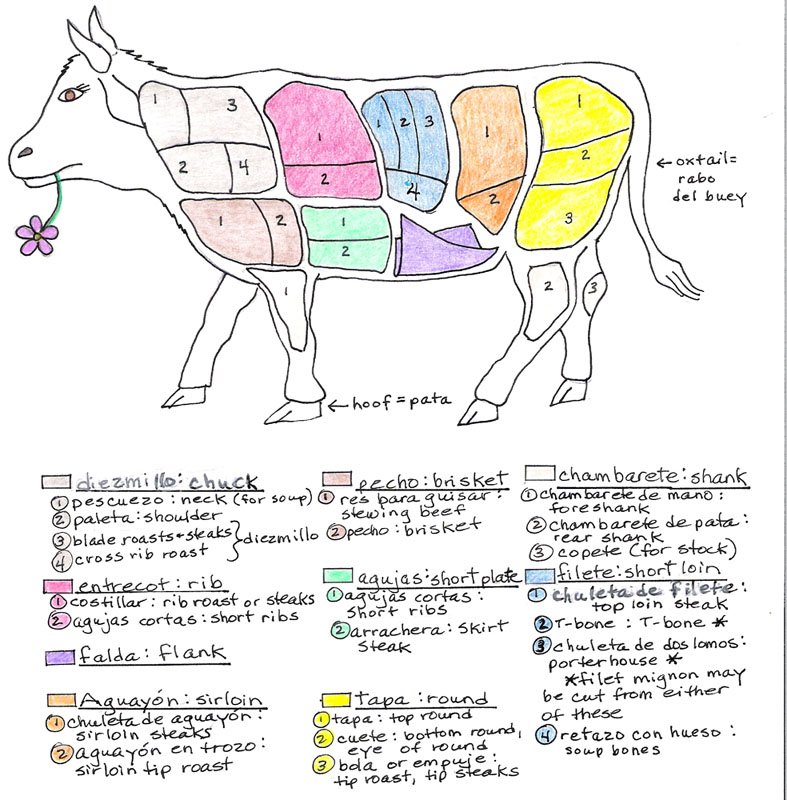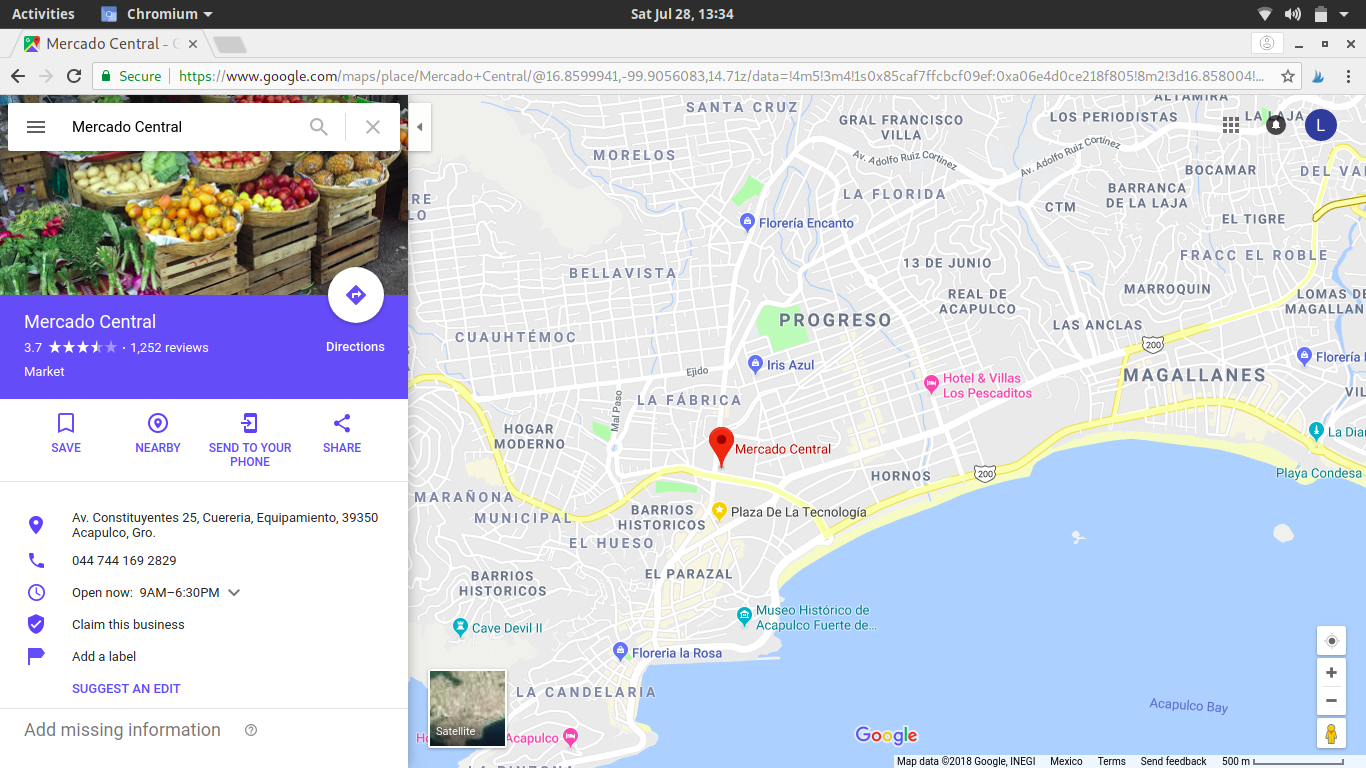
**Photo caption: The photo above is not my drawing but from the post where most of the information I share here was found, the link is included several places below. This has been confirmed correct by a local friend and a local butcher.
So lets talk meat, beef to be exact. When embarking on the carnivore diet in Mexico as a gringo, one is faced with the dilemma of not knowing how to ask for the correct cuts of beef at places like the Central Market where both high quality and low prices can be found.
Frankly I’m tired of walking around yelling “FILET MIGNON” and “RIBEYE” at locals who only sometimes understand which cut I’m referring to. These are coincidentally good ones to yell and they get me those items, and nothing else which is the problem. I’ve so far been too insecure in my Spanish to ask for other cuts!
So with the help of a local friend’s review of this blog post about beef I should be set for the market...so long as I remember the terms. At the very least I can save the map of the cow shown in this post, taken from that original post to show to the butcher. Much of the information shared in this post is from the link in the previous sentence, but it’s been cross referenced by both my friend and his butcher at the Central Market here in Acapulco.
For the purposes of this post, I’m just talking about beef as it’s the one we’ve got the most experience with as we consume more beef than anything. For anyone wondering, beef in Mexico is referred to as carne de res.

For those that aren’t aware the Central Market is a part of what’s known in general here as zocalo or *el centro. * It’s the hub where you can find literally anything for sale if you’re diligent enough to look and ask for it. Part of asking means knowing Spanish or at least having the confidence to try and learn, which is sometimes easier said than done.
Mexican butcheries are in your face and have a tendancy to freak some out that aren’t close to the food chain at all. Seeing huge hunks of meat hanging from hooks in open air and a smiling butcher with a bloody cutting board that speaks only Spanish is a bit intimidating, until you actually talk to the guy and realize it’s fine. I’ve heard some say they wouldn’t purchase meat because of the open air nature, but I’ll be straight when I say I’ve purchased more “bad” meat from the supermarket here than the central Market and we’ve never gotten bad meat from the central market.
The Mexican butcher is highly attentive, so when you order meat he cuts what you ask for up right there in front of you, how you ask for it. If you don’t specify how you want it they’ll either ask or assume and go about it a common Mexican way. Things here are done a bit differnently in terms of trimming and they’ll always assume you want all the fat and bone slivers shaved off unless you tell them otherwise. Considering both are important to a carnivore for things like bone broth, if the cut you want comes with a bone let them know you want it with a bone, con hueso.
Terms for Butcher’s Meat Prep
Milanesa: Sliced thin and pounded flat with a wooden mallet. This makes super thin steaks that are breaded and fried, served as milanesa de res. Just about any meat can be prepared this way if you ask
En trozo: A way of asking for the meat in one piece instead of cut up or prepared some way. I used this yesterday when I was at the one vender when we bought another hunk of filet mignon, so I can cut thicker steaks.
Picada: Chopped finely, almost ground but not quite. Also any meat will be cut this way if you ask
Molido: Ground, a butcher has a set couple of cuts they use but they’ll grind up any cut if you ask
** As far as cuts in general are concerned: Most cuts here are thinner almost always than American cuts. I had some steaks cut corte Americano yesterday and they were less than an inch thick, something most true steak loving people from the US would laugh at.**
A Note for Gringos, or US Citizens: Order in kilos, which one kilo is about 2.25 lbs.
**Note: Even if they have the cut listed on a menu (some have a sign with a list of cuts available) do not expect all butchers to have what you want, for this reason we ask around for our cuts of steak until we find things that either look or sound good. Always ask if they have it by using “Tienes” *do you have) before what you’re asking for or “quiero” (I want). They’ll tell you if they have it, if they do ask for price in kilos, using the phrase “cuanto por kilo (How much per kilo). I’ll include some recent prices I remember from the market with the list of cuts below.
For the purpose of this post being streamlined I won’t go into as much explanation on specific location of these cuts, partially because I think the first image in this post gives a good idea as to where things are. If you’re interested in more description, go to that original post I linked! This is intended to be a quick summary of sorts intended for those in Acapulco!
Cortes de Res
Diezmillo: Chuck
pescuezo: neck (for bone broth)
paleta: shoulder, used for chuck steaks and pot roasts
Blade roasts and steaks
Cross Rib roast which is also called the boneless English Roast
Pecho: Brisket
Cut that can be used for corned beef, called pecho curado when it’s found in Mexico.
Chambarete: Shank
chambarete de mano: Like the post mentions, usually cross cut so it gives little rounds of leg bone with the marrow exposed with each hunk of meat. Exceptional braised then boiled in water for hours until the marrow leaks out of the bones, I know from personal experience.
Copete: used for stock
chambarete de pata: rear shank
Entrecot: Rib
agujas cortas: short ribs
costillas chuletas: rib steaks
Ribeye: one of the few terms that is actually the same, likely why we’ve been eating so much (150 a kilo at the market)
Trozo de rosbif: bone in rib roast
Agujas: Short Plate
agujas: short rib
arrachera: skirt steak
Filete: Steak!
Chuletaide filete: top loin steak
T-Bone
Chuleta de dos lomos: porterhouse filet mignon comes from either of these, we get filet mignon for 170 pesos a kilo at the market
retazo con hueso: soup bones
solomillo: tenderloin
Falda: Flank
suadero: fatty bit used to make tacos
Aguayón: Sirloin
Chuleta de Aguayón: or sirloin steak, both used in Acapulco, 127 ish pesos a kilo right now
Aguayónen trozo: sirloin tip roast
Tapa: Round (Rump Roast)
Cuete: bottom round roast and eye of round
So there you have it for the most part, I’ll again share this link for the original source to this information and the cute little hand drawn graph. I found this post in my search but knowing that terms for things change across Mexico and that the post seemingly was written from an expat living in Mexico City, I had my friend check and make sure I’d be able to use these terms here in Acapulco, at the central market. He even confirmed with his butcher, so I plan to have the little graph on my phone for the next time I go.
Knowing things like this now I’ll be able to get everything I need including bones for bone broth and some different cuts of steak. In a carnivore diet, since all you eat is meat, some diversity in the cuts of meat is always appreciated we’re finding here.
So far we consider the market to the best place for quality and price of meat, especially beef. I know a lot of foreigners will shy away so I will say it isn’t for the faint of heart, but there’s a lot of good stuff to be had there. So if you’re a hungry brave carnivore like me, head to Acapulco’s Mercado Central!
Click here for the d.tube copy of my video adventures through the central market for meat yesterday!
Click here for the youtube upload of that same video for those that can't d.tube!
Check out the links below for more like this one!
Acapulco Adventures: Mercado Central Meat Market!
The Carnivore Experiment: Day 13
The Carnivore Experiment: Day 12
In case you missed them, some of my recent posts:
Kombucha Chronicles: Recent Harvest and Bottling Process Changes!
Jungle Shots: Giant Mountaintop Iguana
So, we got a cat....

Hi there, if you're new to my blog here on Steemit check out this for more information on who we are and how we got here.


